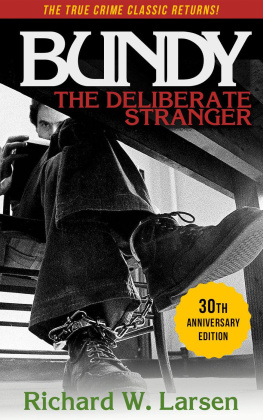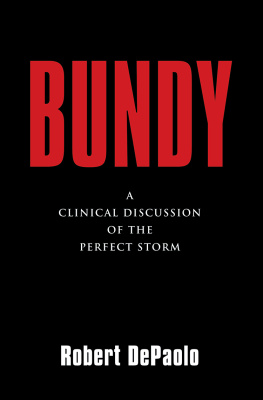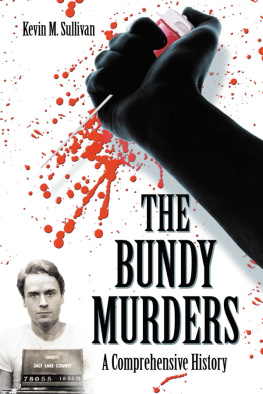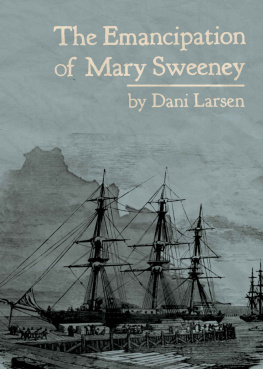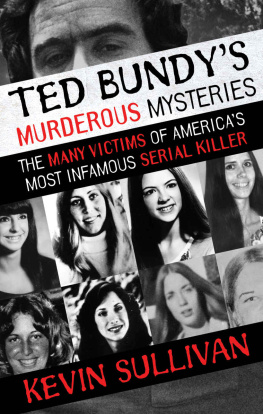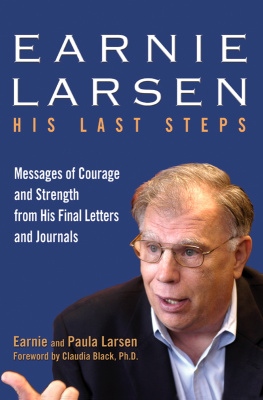Richard W. Larsen - Bundy: The Deliberate Stranger
Here you can read online Richard W. Larsen - Bundy: The Deliberate Stranger full text of the book (entire story) in english for free. Download pdf and epub, get meaning, cover and reviews about this ebook. year: 1986, publisher: Pocket, genre: Non-fiction / History. Description of the work, (preface) as well as reviews are available. Best literature library LitArk.com created for fans of good reading and offers a wide selection of genres:
Romance novel
Science fiction
Adventure
Detective
Science
History
Home and family
Prose
Art
Politics
Computer
Non-fiction
Religion
Business
Children
Humor
Choose a favorite category and find really read worthwhile books. Enjoy immersion in the world of imagination, feel the emotions of the characters or learn something new for yourself, make an fascinating discovery.
- Book:Bundy: The Deliberate Stranger
- Author:
- Publisher:Pocket
- Genre:
- Year:1986
- Rating:5 / 5
- Favourites:Add to favourites
- Your mark:
- 100
- 1
- 2
- 3
- 4
- 5
Bundy: The Deliberate Stranger: summary, description and annotation
We offer to read an annotation, description, summary or preface (depends on what the author of the book "Bundy: The Deliberate Stranger" wrote himself). If you haven't found the necessary information about the book — write in the comments, we will try to find it.
Bundy: The Deliberate Stranger — read online for free the complete book (whole text) full work
Below is the text of the book, divided by pages. System saving the place of the last page read, allows you to conveniently read the book "Bundy: The Deliberate Stranger" online for free, without having to search again every time where you left off. Put a bookmark, and you can go to the page where you finished reading at any time.
Font size:
Interval:
Bookmark:
To Deanie.
And to my children, with apologies for hours and days weve not had together.
And to those families whose lives were touched by these and related events; many of you whom I do not know.
Acknowledgements
My special appreciation goes to James B. King, executive editor, Mason Sizemore, assistant managing editor, Lane Smith, city editor, Don Hannula, other editors, and the management of The Seattle Times who provided that ultimate support so cherished by a reporterthe encouragement and freedom to pursue the story, wherever it leads.
Scores of people provided hundreds of hours of their personal time in interviews with the author. For their assistance, their trust, their confidence, I am especially grateful. It is not possible to list all of you. Special thanks to Eleanore Rose and to James and Shirleen Aime; to Mr. and Mrs. Lyle Manson; to the law-enforcement officers, Michael J. Fisher, Jerry Thompson, Ben Forbes, Paul Forbes, Ira Beal, Brent Bullock, Robert Keppel, Stephen Bodiford, Don Patchen, Bill Gunter, G. Larry Daughtery, Al Pickles, Bill Harris, Bob Campbell, and so many others; to the prosecuting attorneys, David Yocom, Milton K. Blakey, Bob Dekle, and Larry Simpson; to the admirable attorneys who serve the defense, Lynn Thompson, J. Victor Africano, Millard Farmer, John Henry Browne, and others. And special thanks to the helpful staff of the Leon County clerks office, Tallahassee, Florida.
The author is grateful for special friendships which have resulted from this work.
Adele and Robert Monahan provided perfectly-timed support and assistance during preparation of the manuscript. Thank you.
Dick Larsen
AUTHORS NOTE: These events are true. In some rare instances a name has been changed to avoid possible embarrassment to the individual. Where conversations are portrayed, an effort was made to verify their accuracy through interviews with participants.
 |  |


A heavy overcast pressed low on Puget Sound, so that the mountain rangesthe Olympics to the west, the Cascades to the eastwere shrouded from view of the city by a thick, misty February veil. Up from the waterfront, a mottled gray seagull soared past upper windows of Seattles hillside office buildings, on a silent flight above the hum of street traffic below and the sounds of the nearby harbor.
Abruptly, a brilliant white light bathed one seventh-floor room of the federal building, as television crews and newspaper and radio reporters readied themselves for a midmorning press conference in the office of the FBI.
Ah, yes, said a TV technician, peering at his light meter, Ted Bundy goes national.
Other hot lights were switched on. Reporters, opening notebooks, settled into their chairs as a silver-haired Federal Bureau of Investigation agent entered the room and took his place behind a cluster of microphones. John Reed, chief agent of the Seattle FBI office, began reading the official announcement being released across the nation at 10 A.M., local time.
On this date, February 10, 1978, the agent began, Theodore Robert Bundy has been added to the list of the Federal Bureau of Investigations ten most wanted fugitives.... Bundy was a recent escapee from a jail in Colorado and is wanted for questioning in connection with thirty-six sexual slayings which began in California in 1969 and extended through the Pacific Northwest and into Utah and Colorado....
If Theodore Robert Bundy were to be convicted of all the killings in which he is a suspect, the FBI was explaining that day, he would be the most prolific mass murderer in American history.
The most prolific mass murderer in American history.
Ted.
While the FBI man continued to read the prepared statement, my pen paused over the notepad in my lap, and I turned my attention to the newly issued wanted flierthe latest poster which would be thumbtacked on public bulletin boards across America, along with all the other most wanted felons.
Interstate flightMurder, said the headline. Beneath the ten swirl-pattern splotches, which were Ted Bundys fingerprints, were the three photos of Teds face, or, rather, three of Teds faces: left profilegood browline, straight-sculptured nose, loose-knit cardigan on the shoulders, the earnest, scholarly face youd associate with a college campus; then the full facehead cocked to the left and slightly downward, tousled hair, a stubble of beard, eyebrows arched roguishly over intense eyes (I recognized that one as the way he looked after his first escape and recapture); and the lower right photographfull face, looking toward the right, dark turtleneck, long dark hair, a full beard, a flicker of mirth in the almost smoky eyes; a photo which could be that of a leading man in a Shakespeare festival playbill.
Below the photos, the text:
Wanted ... Age 31, born November 24, 1946 ... HEIGHT: 511 to 6 ... WEIGHT: 145 to 175 pounds ... BUILD: Slender, athletic ... Caution: Bundy, a college educated physical fitness enthusiast with a prior history of escape, is being sought as a prison escapee after being convicted of kidnapping and while awaiting trial involving brutal sex slaying of woman at ski resort. He should be considered armed, dangerous and an escape risk.
After the FBI man had completed the routine announcement, reporters asked their questions:
Where do you think Bundy might have gone?
With a shrug, Reed responded, Were just looking for him all over the place. This very morning, he noted, there were news conferences like this one in Salt Lake City and Denvercities in states where there had been many murdered and missing young women. Bundy, whose movements seemed to coincide with murders, had been major crime news in Washington, Utah, Colorado, and elsewhere in the West for months. Now, said the FBI spokesman, the most wanted flier on the man would go to police everywhere in the nation, to attain maximum saturation.
Reed was asked: What about the thirty-six murders of which Bundy is suspected? Could the FBI detail them? Where and whenand howdid all those crimes occur?
He could only respond to that by saying that the FBI received that information from local police jurisdictions in the Western states. The FBI knew little about Bundy, other than that he had become an interstate fugitive when, forty-three days earlier, he had slipped out of jail in Glenwood Springs, Colorado, leaving behind a mound of law books and other items under a blanket on his jail-cell cot, and vanished in a snowstorm.
Local police in Colorado and elsewhere had pleaded with the FBI to put Bundy on the most-wanted list. That would assure a police alert across America, even though there would be no news-media interest in the man in such distant places as, for example, Florida.
As the news conference ended, TV crews dismantled lights, folded tripods, packed their gear, and headed back to studios to edit film and prepare it for the evening newscasts. Newspaper and radio reporters departed for telephones and newsroom typewriters. It would be the days lead story: Ted Bundy on FBIs Most-Wanted List.
Hearing, reading that days news would be scores of people who knew Ted Bundy in earlier yearsas a friend, a college classmate, as a work associate, as that rather good-looking young man whom they had encountered somewhere, one day, by chancepeople who would attempt to reconcile their own memory of him with the always darkening news reports which suggested that wherever Ted Bundy seemed to travel, young women vanished and were murdered.
Next pageFont size:
Interval:
Bookmark:
Similar books «Bundy: The Deliberate Stranger»
Look at similar books to Bundy: The Deliberate Stranger. We have selected literature similar in name and meaning in the hope of providing readers with more options to find new, interesting, not yet read works.
Discussion, reviews of the book Bundy: The Deliberate Stranger and just readers' own opinions. Leave your comments, write what you think about the work, its meaning or the main characters. Specify what exactly you liked and what you didn't like, and why you think so.

